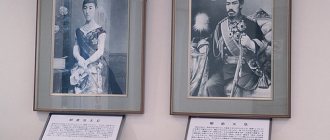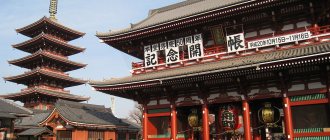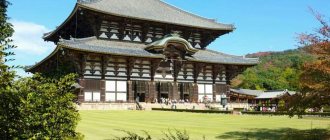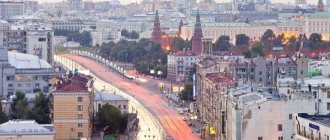Cultural heritage
For a long time, Kyoto was the capital of medieval Japan, where emperors lived, architects created, and history was written. Thanks to its rich past, it is this city that has collected about a quarter of all the most famous architectural monuments of the country.
Every year, thousands of monks and tourists come to the shrines. One of the most popular tourist spots in Kyoto is Ryoanji Temple and its Garden of Fifteen Stones. This place attracts and fascinates tourists from all over the world, possessing a mystical atmosphere.
The Legend of Ryoanji Temple
Reanji means “temple of the peace-loving dragon”, in some sources the name sounds like “submissive dragon”. It is located in the northwestern part of Kyoto and belongs to a small branch of Buddhism - Rinzai.
No one can say with certainty when exactly the garden near the temple was created, but there is a legend associated with the life of the famous master and monk Soami.
It is said that Soami has not survived any material evidence of his existence, and is a semi-legendary person. According to one legend, Soami was poor, he didn’t have “a penny to his name.” And unfortunately, no matter how much he dreamed, they did not want to accept him into Zen Buddhist temples. Then, one day, after one of these refusals, Soami stayed overnight outside the monastery fence.
That night, he dreamed of his father, who told him how to surprise and gain the favor of the monks. Waking up early in the morning, the guy set to work and created the first rock garden in history. In just one day, the master managed to create a symbolic image of the universe, harmoniously recreating all the beauty of nature.
As I said in the previous article, such gardens were erected for philosophical purposes and for reflection. So, the monks, aristocracy or samurai, remained alone with the silent landscape, resting and freeing their minds from worldly bustle and problems.
Similar materials
Inhabited island Aogashima
Aogashima is a volcanic island located in the Philippine Sea. A corner of land 3.5 km. in length and 2.5 km. in width is in the department of Japan….
More details
Japan, Kyoto. Byodo-in Temple.
Byodoin is a Buddhist temple in the city of Uji, Kyoto Prefecture. This is a joint temple of the Jodo Shu (Pure Land) and Tendai movements. Byodo-in Temple…
More details
South Korea. Gyeongju. Bulguksa Temple
Bulguksa is a Buddhist temple in Gyeongsangnam-do Province, South Korea, 13 km southeast of the city of Gyeongju. It contains seven items included in the...
More details
Western Sayan Mountains, Ergaki
Ergaki is an array of multidirectional ridges, spurs largely processed by the glacier. Alpine terrain in the central part of Europe...
More details
Description of the garden
The total length of Ryoanji Garden is 31 meters with a width of 15 meters. The entire rectangular plane is covered with snow-white gravel, the neat stripes on which symbolize ripples on the water.
All the stones are divided into five groups, around which green moss is densely planted. There are fifteen stones in the complex, but it is impossible to see them all at once. Each of them carries a special meaning. Thus, large vertical rocks are used to depict mountains or the sky; they symbolize stability and security. Flat and long stones symbolize the islands.
The garden is fenced with a clay fence. Approaching from the other side - from the veranda for contemplation, you can find a small vessel with water for ritual ablution - this is Ryoanji tsukubai. Hand and face washing takes place here before tea ceremonies. To undergo the ritual, you need to bend down, since the tsukubai is located almost at the same level with the ground, thus, willingly or not, visitors express their deepest respect to the temple complex.
The mysterious place is located inside the temple complex, so you can only get to it by passing through the monastery of the same name. Contemplation of the philosophy of stone images takes place from the veranda of the temple.
Ryoanji (Temple of the Rest Dragon) is a Buddhist temple in Kyoto dating back to 1450 that belongs to the local Rinzai school of Zen Buddhism. Patrons of this temple included shogun Tokugawa Ieyasu and military dictator Toyotomi Hideyoshi, who lived during Ryoanji's heyday. However, at the end of the 18th century, many of the temple structures were destroyed and destroyed by fires. Now the temple is known only for its rock garden, made in Zen Buddhist style. It is considered one of the most amazing and famous philosophical gardens. There is an assumption that the author of this Ryoanji garden was the famous Japanese master Soami.
The garden is a small rectangular area (10 meters from south to north, 30 meters from east to west), covered with white gravel. There are 15 stones on it, organized into five groups. Green moss is planted near each group as a frame. And the gravel is “combed” with a rake into the finest grooves, which are associated with soft ripples of water. Ryoanji Garden is surrounded on three sides by a low adobe fence.
This garden is part of the temple structure, so tourists can only approach it by passing through the temple itself. You can only contemplate it while sitting on the veranda of the Japanese Temple of the Rest of the Dragon.
What do the stones in the garden represent? Some believe that these are five mountain peaks that rise to the sky through the clouds, while others think that they are five islands in the ocean without shores, others are sure that this is a tigress swimming across a stormy sea with her cubs. The associative series is simply endless. However, there are also many other secrets in this garden.
One of them, for example, is that the viewer will always be able to see only 14 stones, no matter from which side of the veranda he looks at the garden, each time one of the stones will disappear from his field of vision. Perhaps the Zen Buddhist monk Soami thus tried to show humanity the immensity of the world, the greatness of Buddha, the power of the Cosmos, making it clear that in the vast world there is a lot of incomprehensible, hidden things.
Another mystery of the garden is its hypnotic effect on humans. After all, contemplation of stones gives the viewer the opportunity to concentrate, go deeper into oneself and find a calm state of mind. Ryoanji Garden was created by Master Soami for the meditation of monks. In the infinity of associations that are born in different lighting and at different times of the year, each viewer finds something different in the outlines of stones. The most important and secret thing for him. The secrets of the Ryoanji garden, like the secret of the Mona Lisa's smile, are incomprehensible, eternally mysterious and beautiful.
Book a hotel in Kyoto
To explore the sights of Japan, in particular the interesting places of Kyoto, you will need to stay somewhere. Especially for you, below are Kyoto hotels divided into three categories: popular hotels, luxury hotels and cheap hotels. Here you can book a Kyoto hotel room in advance according to your wishes and financial capabilities. For your convenience, here is information about the location of the hotels relative to the city center, as well as the number of stars.
Simply select the hotel you like by clicking on the “View Hotel” button. Next you will find yourself on a page where you can book a hotel. There you can also find more detailed information about it, reviews, ratings, photographs, location on the map, features and, of course, prices.
If you want to look at other hotels, you can simply select the city “Kyoto” from above, and you will see a list of all Kyoto hotels available for booking.
Philosophy of stone figures
Just from here, you will see all the splendor of the Ryoanji complex. But the mysticism of this complex lies precisely in fifteen stones. From any observation position, visitors only have a view of fourteen stones, no matter how you walk. With each step, the lined figure changes, and the stone that was hidden earlier becomes visible, but another stone silently hides. So, step by step, visitors excitedly look and search for the mysterious fifteenth stone.
Monks who study Zen Buddhism say that it is almost impossible to see all the components of the complex at once. Only an enlightened person who has achieved an understanding of existence through long daily meditations can see the entire complex of 15 stones. Comprehension of the secret symbolizes the complete harmonious coexistence of man and nature.
For many years now, people have been trying to unravel the mystery of the construction idea. What did Soami want to convey in his work of art? At the moment there are several versions:
- The most popular belief is that five groups of stones symbolize the five largest peaks of Japan
- According to other sources, these are five islands in the endless ocean
- Someone cites an association with a Chinese legend, comparing the stones with a tigress and her cubs
There are many versions and they are varied. So far, no one has gotten to the truth. But this is the whole uniqueness of the philosophical garden!
And one more interesting point. They say that Ryoanji Garden has hypnotic properties - visitors seem to be mesmerized by the landscape. Every year, a huge number of tourists come here. The minimalism and asceticism of the creation attracts the attention of people from different parts of the world. Contemplation of stones calms the spirit, gives you the opportunity to withdraw into yourself and concentrate. Probably, the garden inherited this property from its creator - a monk, a master of meditation.
Ryoanji Rock Garden
Perhaps one of the most important shrines of Zen Buddhism, the Ryoanji Temple, was built in 1450 and became a refuge for monks who adhered to Zen philosophy. His patrons included Tokugawa Ieyasu and Toyotomi Hideyoshi.
In the 18th century, the shrine experienced decline, and most of the buildings were destroyed by fires. Today, the temple is famous for its Zen Buddhist style rock garden, which is one of the most famous and amazing attractions in Japan. According to surviving writings, the author of the garden is the famous author Soami.
The incomprehensibility of spiritual depths
The garden is designed in the form of a small rectangular area, fenced with an adobe fence on three sides. The entire area is covered with white gravel, and on it there are 15 stones, organized in five groups. The gravel itself is raked into thin stripes, creating the feeling of soft water ripples.
The Ryoanji rock garden is part of the temple structure, so you can only get to it through the temple premises, and you can enjoy this splendor while sitting on the veranda.
For everyone who contemplates this beauty, their own associations arise. For some, these are five mountain peaks soaring into the clouds, for others - islands in the endless expanses of the ocean... In general, it all depends on your purity and depth of your inner world. Perhaps the main mystery of this creation is that no matter from which side you look at the garden, you will only be able to see 14 stones, and one of them will always disappear from view.
Mind games
An equally interesting mystery of the garden is its hypnotic effect on humans. Contemplating the stones, there is an opportunity to think about the highest, find peace of mind and spirit, and immerse yourself in yourself. However, it was precisely for the meditation of the monks of the temple that it was created by the master.
The mysteries of such a charming Kyoto landmark can only be understood through silent reflection. But this can be done only after the opening of the garden, when no one is there yet. Just below is another garden, created in an era when the teachings of Zen had not yet reached Japan. No less charming, with its smooth and soft curves it creates a magnificent frame for the harsh spirituality of the philosophical rock garden.
Today, this unique creation of human hands and a beautiful, mesmerizing place is on the UNESCO list as a most valuable historical object and cultural monument. Another of the most beautiful and ancient attractions of Kyoto is the Fushimi Inari-taisha Shrine, built in 711.
Garden exploration
Not long ago, students and part of the teaching staff from Kyoto University, through new technological methods, made some progress in studying the arrangement of stones in the Reanji Garden.
The study showed that although the arrangement of stones seems completely random, it has a strictly defined sequence. All stones are laid out in the shape of a tree crown, symbolizing the development and evolution of human nature.
Most likely, the creator unintentionally, on an intuitive level, erected a complex that enchants the consciousness, with an incredible semantic background. So, the secrets of the philosophical garden largely remain unsolved to this day, I think if you visit this place, you will find something new for yourself.
And with this, I finish my acquaintance with the famous Ryoanji temple complex. I hope that this information was useful and interesting for you. Subscribe to my blog and recommend it to your friends. See you later!
Lika Raido
Temple
Reanji is located in the Ukyo district in the northwest of Kyoto. It goes back to the direction of Zen Buddhism, the Rinzai school, a branch of Meshinji. The name is translated from Japanese as “abode of the peaceful dragon.”
Reanji was built in the mid-15th century and subsequently became one of Kyoto's main attractions, preserving traditional Japanese heritage. Since the end of the last century, it has been listed as a UNESCO World Heritage Site. Now hundreds of tourists flock here every day, most of whom want to see the rock garden.










